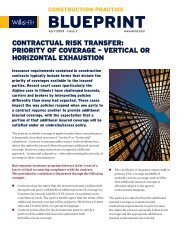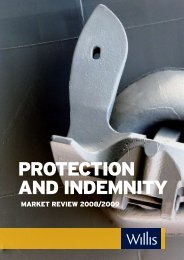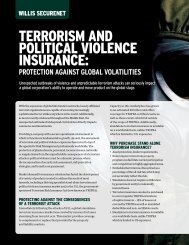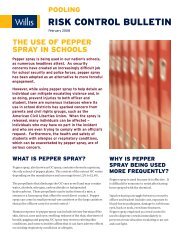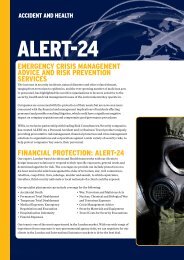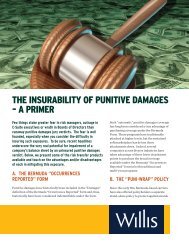spRING 2011 GlobAl MARKETs INTERNATIoNAl - Willis
spRING 2011 GlobAl MARKETs INTERNATIoNAl - Willis
spRING 2011 GlobAl MARKETs INTERNATIoNAl - Willis
You also want an ePaper? Increase the reach of your titles
YUMPU automatically turns print PDFs into web optimized ePapers that Google loves.
Tom: “And moving on from the risks themselves to their prevention<br />
and/or mitigation, what actions should senior management take to<br />
address the various risks you have highlighted?”<br />
Lachy: “From an enterprise risk management perspective, companies<br />
should be reviewing their current risk management processes and<br />
assessing whether they are still ‘fit for purpose’, given the changes that<br />
have been wrought on the sector over the past three years.<br />
Many mining companies undertake some form of risk assessment, but<br />
these are often conducted on an infrequent basis. Such assessments need<br />
to be institutionalised as a regular (at least annual) part of the strategic<br />
planning process. It is important that the assessment identifies key risks<br />
and weights the likelihood of the risk materialising, with a view on the<br />
impact on the broader business. Inter-relationships between the various<br />
risks should also be considered.<br />
For the major risks identified, management should test various<br />
scenarios, and develop a number of operational responses. In the current<br />
environment, such scenarios should test against wide ranging potential<br />
market outcomes, including volatile commodity prices and foreign<br />
exchange rates, and address adequacy of liquidity arrangements under<br />
the various outcomes.<br />
The company’s ability to manage the risks that are identified must be<br />
evaluated to ensure that the risk management processes are linked to<br />
the risks the business actually faces. Adequate monitoring and control<br />
processes should also be maintained to provide early warning, and to<br />
improve timeliness of response. It is important that risk management<br />
is seen as a critical aspect of operations, and responsibility and<br />
accountability extend from Head Office to product groups and asset sites.<br />
From a transactions perspective, highly effective due diligence processes<br />
should be used to identify the broad transaction risk areas, thereby<br />
enabling management to assess their tolerance for the risk, and then,<br />
if necessary, build decisive remedial action into a post-deal integration<br />
plan. The post-deal integration plan should include a detailed followthrough<br />
on any unresolved transaction issues identified pre-acquisition<br />
and to explore any areas that were abbreviated due to time pressure or<br />
other constraints.<br />
With the emphasis on expansion into emerging<br />
markets, there are a number of critical diligence<br />
issues which might not be relevant in more<br />
developed markets. These include, but are not<br />
limited to, settlement agreements, outstanding<br />
tax liabilities, tax arrangements with the<br />
incumbent Government, ratification of mining<br />
documents with the appropriate parliamentary<br />
body ( for example, the National Assembly in<br />
Guinea), procure to pay processes and security<br />
of tenure, particularly if an existing project<br />
has been delayed by civil war or lack of finance<br />
for example and is not producing the expected<br />
economic benefit for the host country.<br />
It is important that any individual project or<br />
transaction is tested against a range of possible<br />
outcomes and be evaluated in the context<br />
of that which will most enhance the overall<br />
portfolio value (versus standalone value). This<br />
is important to ensure there is a balance of<br />
investment across commodity or product groups.<br />
Understanding the capital formation process<br />
is critical to mitigating financing risks.<br />
Management need to understand the alternative<br />
sources of finance, especially as capital markets<br />
continue to disintermediate, and how to access<br />
those pools of capital at short notice. This<br />
requires a dialogue to be opened with potential<br />
capital providers well ahead of the need for<br />
capital, so a mutual trust and understanding of<br />
each other’s business is developed away from the<br />
pressures of a financing.”<br />
<strong>Willis</strong> | Mining Market Review <strong>2011</strong> | 87






